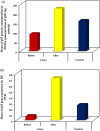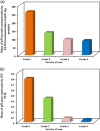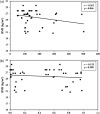Isotretinoin treatment upregulates the expression of p53 in the skin and sebaceous glands of patients with acne vulgaris
- PMID: 36585988
- PMCID: PMC10205870
- DOI: 10.1007/s00403-022-02508-y
Isotretinoin treatment upregulates the expression of p53 in the skin and sebaceous glands of patients with acne vulgaris
Abstract
The transcriptomic regulation induced by isotretinoin (13-cis retinoic acid) is still a matter of debate as short-term exposures of immortalized sebocytes with isotretinoin produced conflicting results. Based on translational evidence, it has been hypothesized that oral isotretinoin treatment upregulates the expression of the transcription factor p53. Twenty-five patients suffering from acne vulgaris were treated with isotretinoin (0.6 mg/kg body weight) for 6 weeks. Biopsies from back skin were taken before and after isotretinoin treatment for the determination of p53 expression by immunohistochemical staining, quantification of p53 protein concentration by enzyme-linked immunosorbent assay and TP53 gene expression by quantitative reverse transcription real time PCR. Fifteen socio-demographically cross-matched healthy volunteers served as controls. Isotretinoin treatment significantly increased the nuclear expression of p53 in sebaceous glands of treated patients compared to pre-treatment levels and p53 levels of untreated controls. Furthermore, the p53 protein and gene expression significantly increased in the skin after treatment. The magnitude of p53 expression showed an inverse correlation to acne severity score and body mass index. Under clinical conditions, isotretinoin induced the expression of p53, which controls multiple transcription factors involved in the pathogenesis of acne vulgaris including FoxO1, androgen receptor and critical genes involved in the induction of autophagy and apoptosis. Increased p53-FoxO1 signalling enhanced by systemic isotretinoin treatment explains the underlying transcriptomic changes causing sebum suppression but also the adverse effects associated with systemic isotretinoin therapy.
Keywords: Acne; Gene expression; Isotretinoin; Sebaceous gland; p53.
© 2022. The Author(s).
Conflict of interest statement
The authors have no conflict of interest to declare.
Figures




Similar articles
-
Acne Transcriptomics: Fundamentals of Acne Pathogenesis and Isotretinoin Treatment.Cells. 2023 Nov 10;12(22):2600. doi: 10.3390/cells12222600. Cells. 2023. PMID: 37998335 Free PMC article. Review.
-
Effect of oral isotretinoin on the nucleo-cytoplasmic distribution of FoxO1 and FoxO3 proteins in sebaceous glands of patients with acne vulgaris.Exp Dermatol. 2018 Dec;27(12):1344-1351. doi: 10.1111/exd.13787. Epub 2018 Oct 17. Exp Dermatol. 2018. PMID: 30240097
-
Autophagy regulates lipid production and contributes to the sebosuppressive effect of retinoic acid in human SZ95 sebocytes.J Dermatol Sci. 2020 May;98(2):128-136. doi: 10.1016/j.jdermsci.2020.04.001. Epub 2020 Apr 18. J Dermatol Sci. 2020. PMID: 32354609
-
Neutrophil gelatinase-associated lipocalin mediates 13-cis retinoic acid-induced apoptosis of human sebaceous gland cells.J Clin Invest. 2008 Apr;118(4):1468-78. doi: 10.1172/JCI33869. J Clin Invest. 2008. PMID: 18317594 Free PMC article.
-
p53: key conductor of all anti-acne therapies.J Transl Med. 2017 Sep 19;15(1):195. doi: 10.1186/s12967-017-1297-2. J Transl Med. 2017. PMID: 28927457 Free PMC article. Review.
Cited by
-
Assessing Anti-Acne Potentials Via In vitro, Ex vivo, and In vivo Models: A Comprehensive Approach.Curr Drug Targets. 2025;26(7):435-453. doi: 10.2174/0113894501335548250123072644. Curr Drug Targets. 2025. PMID: 39886785 Review.
-
Systematic Review of Rare Major Adverse Cardiovascular Events Associated With the Treatment of Acne With Isotretinoin.Australas J Dermatol. 2025 May;66(3):e97-e108. doi: 10.1111/ajd.14424. Epub 2025 Feb 10. Australas J Dermatol. 2025. PMID: 39927601 Free PMC article.
-
Enhanced triglyceride adsorption by steam-activated bamboo charcoal based on molecular dynamics investigations.Sci Rep. 2024 Mar 14;14(1):6237. doi: 10.1038/s41598-024-56902-9. Sci Rep. 2024. PMID: 38486101 Free PMC article.
-
Acne Transcriptomics: Fundamentals of Acne Pathogenesis and Isotretinoin Treatment.Cells. 2023 Nov 10;12(22):2600. doi: 10.3390/cells12222600. Cells. 2023. PMID: 37998335 Free PMC article. Review.
-
Circulating biomarkers of oxidative stress in people with acne vulgaris: a systematic review and meta-analysis.Arch Dermatol Res. 2024 Mar 15;316(4):105. doi: 10.1007/s00403-024-02840-5. Arch Dermatol Res. 2024. PMID: 38489064
References
-
- Plewig G, Melnik B, Chen W. Plewig and Kligman´s Acne and Rosacea. Cham: Springer; 2019. Acne pathogenesis; pp. 45–61.
MeSH terms
Substances
LinkOut - more resources
Full Text Sources
Other Literature Sources
Medical
Research Materials
Miscellaneous

